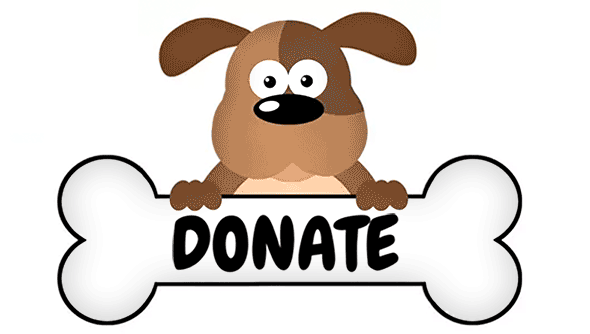Housetraining
Everybody appreciates a housetrained dog. Whether you have a new puppy or are adopting an older rescue dog, the principles for housetraining are the same. With consistency, patience and routine, your dog most likely will be doing all of his business outside within a few weeks.
Getting Started
Make sure you have bought your housetraining supplies and have made your decisions about where outside your puppy should go before you bring your puppy home. Each accident makes the next one more likely to happen.
- Crate: Dogs will rarely soil where they sleep. Be sure the crate is big enough for your puppy to turn around, but not so big that he can pee on one side and curl up on the other. Generally, crates should be 1 ½ times your puppy’s length, without his tail. Keep in mind that you need to acclimate your dog to his crate gradually; don’t just force your dog inside and shut the door. Feeding your dog in his crate with the door open and throwing in treats for him to find are two ways to help your dog like his crate. Don’t overdo crate time! Puppies shouldn’t spend more than about 6 hours total during the daytime in a crate, and those hours should never be consecutive. Even a housetrained puppy can’t be expected to hold his bladder longer than he is physically able – generally 1 hour longer than his age in months.
- Leash: Keep a leash by the door or around your waist, so that you are ready to take your dog out at any time. Take your dog outside on leash, even if you have a yard, so that you can be certain that he has actually gone.
- Potty Area: Choose a place in your yard or just outside your home where you want your puppy to eliminate. Every time you take your dog outside, you will go straight to that area and wait.
- Gates or Exercise Pens: You can use baby gates to confine your dog, if he isn’t yet used to the crate, or to give a large dog additional space. An exercise pen can work only if your dog is small enough that he won’t knock it down.
- Treats: Have treats, cut into pea-size pieces, on you, so you can reward your puppy immediately (within 3 seconds) when he eliminates outside.
- Enzymatic Cleaner: Accidents will happen, so be prepared with a cleaner that is designed to eradicate the odor. This will make it less likely that your dog will smell his first mistake and then use that spot again.
Consistent Routines
Consistent schedules, including feeding schedules, are essential for successful housetraining. If you leave food out all day, you will have a much harder time housetraining your dog. Routine helps your dog go at regular intervals and helps you recognize when your dog will be ready, so you can be proactive.
When you are first housetraining, give your puppy plenty of opportunities to eliminate outside … and be rewarded for it. Your pup should go out after sleeping, eating, playing, and before going to bed. Small dogs have smaller bladders and need to go more frequently.
Until your puppy is 5 – 6 months old, you can’t expect him to control himself for long periods of time. Since dogs aren’t as active at night, they don’t have to go as often during nighttime. However, young puppies can’t make it overnight without going out. It helps to have a crate in your bedroom, so you can hear your puppy moving around and scratching and can take him out. Some people even set their alarms for the middle of the night. When you do go outside at night, it should be all business. No talking, playing, or petting. Of course, you should still give your puppy a tiny treat when he eliminates.
Putting it on Cue
Going potty and going for a walk should be two separate issues. Otherwise, you will have to take your dog for a walk, even if you have a fever or there’s a bad storm. Take your puppy to the same “potty place” every time, and wait. If your dog has had an accident inside, putting the paper towel that you used to clean up in the puppy’s outdoor place will encourage your puppy to go there. As your puppy starts to eliminate, use a cue like “Go Potty”, “Hurry Up”, or whatever else you and your family have agreed on. The second your pup finishes going to the bathroom, give him a few tiny treats, one after the other, and praise. Try to stay outside another ten minutes to see if your pup has eliminated completely. If your dog doesn’t go at all, bring him in, put him in his crate, and try 15 – 30 minutes later. If your dog does go, you can always use a walk as an additional reward.
Supervision
When people have trouble housetraining their dog, it’s usually because they have given their dog too much freedom too soon. Whenever you bring your dog inside, he should either be confined or tied to your waist. If you are confident that your dog has eliminated completely, he could be with you in a gated area or ex-pen for thirty minutes after going, since this is when your pup is least likely to go again. That way, if you see that he needs to potty (scratching, circling, starting to lift his leg or tail…), you can rush him outside quickly (and happily) and reward him when he pees or poops outside. Bottom Line: Either your dog is outside going to the bathroom on leash (yes, even if you have a yard) in your potty area or your dog is crated, tied to you, or confined where you can watch him.
Accidents Happen
No matter how much planning you do, accidents can happen. Punishing your dog or sticking your dog’s nose in it won’t help. Let’s say that again – Punishment will not help, and it may harm. Punishment after the fact is useless. Dogs don’t connect a punishment with what they did even 5 minutes ago. You may think you’re punishing your dog for eliminating inside, but your dog may think you’re punishing him for eliminating where you can see it. If you scold your dog while he is in the act of going, he will learn not to go in front of you. This can result not only in dogs that hide behind couches to do their business, but also in dogs that won’t do their business outside with you holding the leash. If you see your dog beginning to pee in the house, don’t shout or hit. Simply say something, like “uh-oh”, to interrupt him, and run him outside, where you can praise and treat him for finishing. If your dog is small enough, you can even scoop him up to get him outside.
When you clean an accident, soak up the urine and then use an enzymatic cleaner specifically intended for pet accidents. Dogs tend to return to areas where they have gone before; so, it’s crucial to remove the remnants, including the odor. If this dog, or a prior dog, has gone all over the house, you may need to check for
stains with a black light (available at hardware stores) and then use a steam cleaner, not on a hot setting, for set-in stains and odors.
Re-Training A Rescue Dog
Always assume that any new dog you bring into your home is not housetrained. Even if he was trained once, the stress of a new environment, time in a shelter, new signals and routines can all undo his housetraining. It’s better to let your dog out too many times than risk having an accident indoors. The good news is that if your rescue dog was housetrained once, re-training him should be relatively quick.
Other Reasons for Indoor Elimination
- When your dog’s bathroom habits have changed, first explore medical causes. Your dog could have a urinary tract infection, bladder stones, or parasites.
- A dog may roll over on his back and pee slightly or poop may just fall out when a dog is afraid of someone or something.
- Some dogs leak when they’re excited, especially during greetings.
- One sign of separation anxiety may be eliminating inside while the dog’s person is gone.
- Sometimes, a dog will urine mark to claim territory around an unfamiliar dog. This is most common among males, but an occasional female will do it, too.
- Dogs raised in puppy mills lived, peed, and pooped in their kennels. These dogs will go to the bathroom in their crates, but may not go outside on grass. If you have a puppy mill dog, housetraining will likely be a much slower process.
A Last Resort
When you have tried for months, explored other options, and your dog still isn’t housetrained, you may need to consider something to catch the pee. Males can wear belly bands and females can wear panties with half of an incontinence pad tucked in. Belly bands can also help protect your furniture from a dog that marks.
Key Points to Remember
- Take your puppy out at regular intervals, so you have plenty of opportunities to reward your puppy for eliminating outside. Your pup should go out after sleeping, eating, playing, and before bedtime.
- Have a designated potty place, where you always take your dog to eliminate. Praise and give your dog small treats immediately after your dog eliminates.
- Between trips outside, your puppy should be confined, crated, or tied to you.
- Don’t punish your dog for accidents. Dogs don’t eliminate inside to spite you. Punishment can also have unintended consequences.
- Unless you clean accidents thoroughly, dogs will return to the same indoor spots to eliminate.
- Assume that your rescue dog isn’t housetrained.
- Consider whether your dog has medical or other issues causing housetraining problems.
Resources
Way to Go! How to Housetrain a Dog of Any Age, Patricia McConnell & Karen London
Attend Welcome Home, Pup!, a live, free monthly webinar full of practical tips and advice for anyone who has recently welcomed home a rescue, foster dog, or new puppy.
Still Need Help?
Contact Your Dog’s Friend at [email protected] or (301)983-5913 for advice and referrals or check out our list of recommended trainers and behaviorists.
Your Dog’s Friend is a nonprofit 501(c)(3) organization working to improve dogs’ lives, reduce problem behaviors, and keep dogs out of shelters, by educating and supporting their humans.
This material is not intended to be a substitute for professional help when dealing with dogs with intense or potentially dangerous behavior issues. Consult a positive reinforcement trainer or veterinary behaviorist for professional assessment, guidance, and support.




